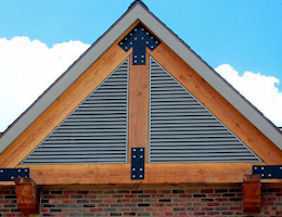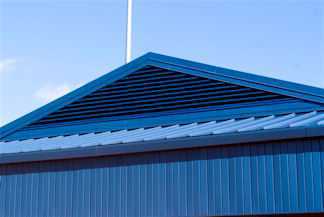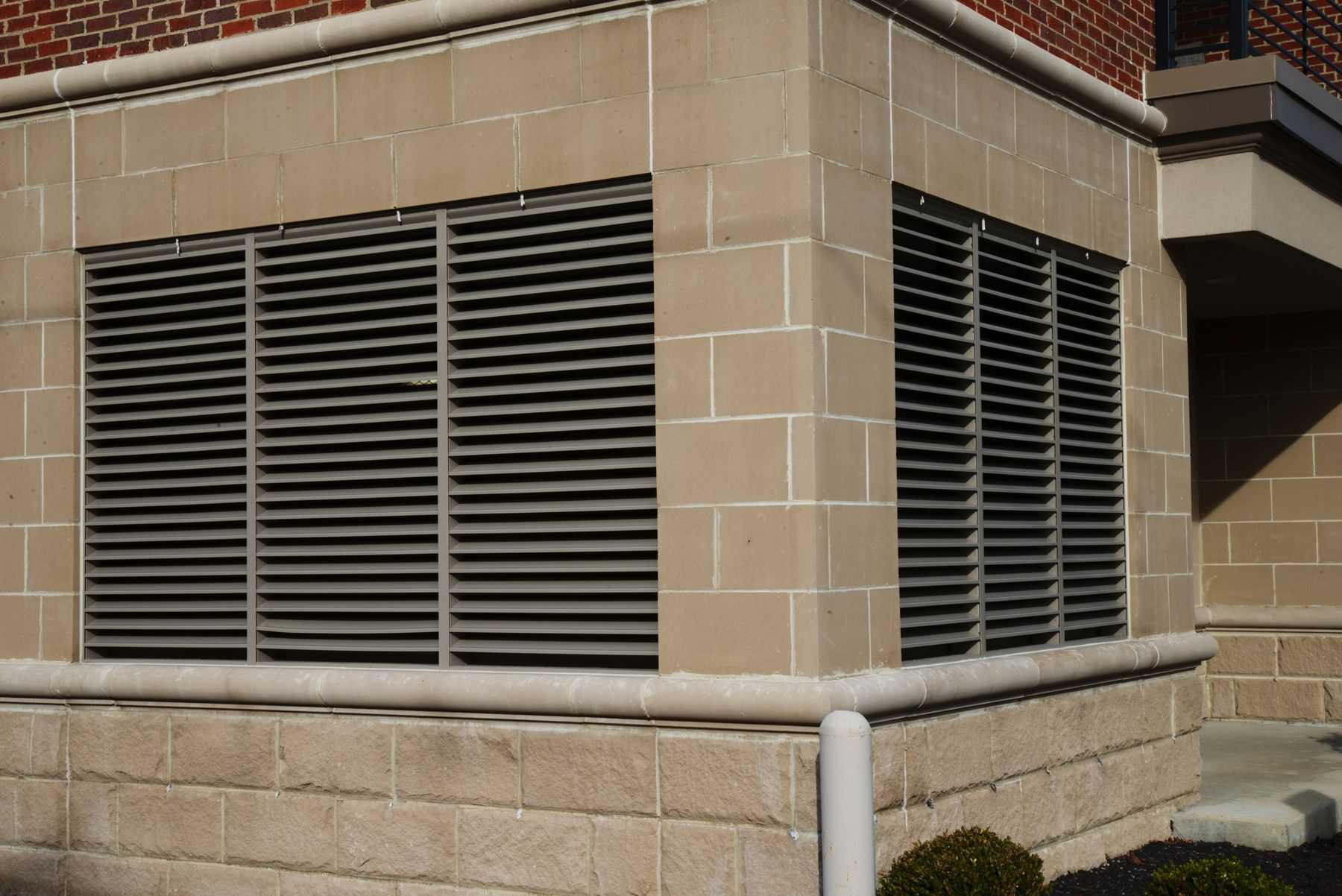Louver Applications
Architectural Wall Louvers are used to allow air into a building, while keeping out undesirable elements from mother nature like rain, water, dirt, and debris. They also add the extra element of aesthetic design to a building exterior. Use your air intake or ventilation requirements to improve the look of any building.
Use the following methods to select the right louver for your application:
| Common Criteria : | Ask Yourself : |
| Select by Application | What will the louvers need to do? |
| Select by Free Area | How much air needs to go through the louvers? |
| Select by Price Range | How do the louver prices compare? |
| Other Considerations | What about appearance, wall depth and type, special shapes, mounting options, and finishes? |


Use the Following table to select the correct louver type for your application:
| Louver Application | Louver Type | Model |
| Decorative, Air Exhaust, Ventilation | Standard Blade Louvers | E2JS E4JS |
| Highest Free Area (69%) | Narrow Blade Louvers | E6JN |
| Lower Pressure Drop, High Air Exhaust Velocity | Standard Blade Louvers (Performance Series) | E4JP E6JP |
| Air Intake or High Wind Areas | Drainable Blade Louvers | E2DS E4DS |
| Air Intake, High Wind, Low Pressure Drop, High Air Intake Velocity | Drainable Blade Louver (Performance Series) | E4DP E6DP |
| Extreme Weather, Air Exhaust or Open Ventilation | Wind Driven Rain Louver | E4WS |
| Extreme Weather, Extreme Intake Air Velocity | Wind Driven Rain Louver | E2WV E4WH E6WH |
| Extreme Wind, Decorative, Air Intake and Exhaust | Hurricane Standard Blade Louver | E6JF |
| Extreme Wind, Extreme Weather | Hurricane Wind Driven Rain Louver | E6WF |
| Equipment Screen Application | Louver Type | Model |
| Full visual screening from horizontal sight line or below, blades horizontal | Inverted Standard Blade Louvers | V2KS V2KSD V4JS V4JSD |
| Full visual Screening from all angles, blades horizontal | Sight Proof Blade Louvers | V4YH V4YHD |
| Full visual Screening from all angles, blades vertical | Sight Proof Blade Louvers | V4YV |
| Full to partial visual screening from horizontal sight line, excellent wind load reduction on structural framing, blades horizontal | Inverted Narrow Standard Blades at 3", 4" or 5" blade spacing | V6JN |
Select the louver models by free area:
Table is based on a test size of 48" wide x 48" high for comparison purposes:
| Product Model | Free Area | First Point of Water Penetration (free area velocity) | Overall Performance (C.F.M.) | Pressure Loss at this velocity (inches water gauge) |
| E6JN | 69.1% | 915 fpm | 9014 cfm | 0.12 |
| E4DP | 59.3% | 930 fpm | 8826 cfm | 0.12 |
| E4JP | 58.4% | 960 fpm | 8976 cfm | 0.13 |
| E6DP | 57.7% | 1046 fpm | 9655 cfm | 0.13 |
| E6JP | 57.3% | 1123 fpm | 10298 cfm | 0.18 |
| E4DS | 56.0% | 930 fpm | 8333 cfm | 0.13 |
| E4WS | 56.0% | 346 fpm | 3100 cfm | 0.02 |
| E6JF | 54.4% | 1020 fpm | 8884 cfm | 0.18 |
| E2WV | 53.8% | 889 fpm | 7645 cfm | 0.24 |
| E6WH | 51.4% | >1250 fpm | 10275 cfm | 0.21 |
| E6WF | 51.1% | >1081 fpm | 8832 cfm | 0.14 |
| E4WH | 50.6% | >1250 fpm | 10113 cfm | 0.25 |
| E4JS | 50.4% | 888 fpm | 7157 cfm | 0.15 |
| E2DS | 49.4% | 889 fpm | 7032 cfm | 0.12 |
| E2JS | 48.7% | 725 fpm | 5648 cfm | 0.08 |
More about Louver Free Area
Select the louver models by price:
| Product Model | Price Compare* |
| E4JS | Least Expensive |
| E2JS | 5% more than E4JS |
| E4DS | 10% more than E4JS |
| E2DS | 10% more than E4JS |
| E4WS | 12% more than E4JS |
| E4JP | 15% more than E4JS |
| E4DP | 25% more than E4JS |
| E6JP | 30% more than E4JS |
| E6DP | 35% more than E4JS |
| E6JF | 35% more than E4JS |
| E6JN | 40% more than E4JS |
| E2WV | 50% more than E4JS |
| E4WH | 95% more than E4JS |
| E6WH | 120% more than E4JS |
| E6WF | 125% more than E4JS |
*Price values are for comparison purposes only. Actual quotation prices may vary depending on the sizes required and the options selected.
The louver appearance should play a significant role in louver selection. It is often ignored in favor of "function over form". However, with so many high performance louvers available the appearance can play a significant role. For example, if your louver heights are small, you will want a narrow blade spacing. This will allow more blades in the frame and improve the appearance. Below are our louver blade spacings listed by model:
| Product Model | Blade Spacing | Frame Depth | Wall Depth |
| E2WV | 0.75" vertical | 2" | >3.5" |
| E2JS | 2.00" | 2" | >3.5" |
| E2DS | 2.00" | 2" | >3.5" |
| E4JP | 3.00" | 4" | >5.5" |
| E4DP | 3.00" | 4" | >5.5" |
| E4DS | 4.25" | 4" | >5.5" |
| E4WS | 4.25" | 4" | >5.5" |
| E4JS | 5.00" | 4" | >5.5" |
| E6JN | 3.00" | 6" | >7.5" |
| E6JP | 4.00" | 6" | >7.5" |
| E6DP | 4.00" | 6" | >7.5" |
| E6JF | 4.00" | 6" | >7.5" |
| E4WH | 2.00" | 4" | >5.5" |
| E6WH | 4.25" | 6" | >7.5" |
| E6WF | 4.00" | 6" | >7.5" |
Special shape louver suggestions: best choice E4JP
- Use non-drainable louvers (models with J blades)- since drainable louvers have a gutter in the jambs, they will not drain properly when used for many of the special shapes. To view common special shapes click here.
- Use narrow blade spacings - the appearance will be more uniform (especially in short height louvers). E4JP and E2JS
- Use high free area louvers - many of the special shapes have restricted free areas due to angles or rounding. A higher free area louver will help combat this loss of free space. E4JP and E6JP
Review the impact of special shapes on Louver Free Area
Home How Louvers Work How Equipment Screens Work How Sunshades Work Wall Louver Applications Louver Free Area Hinged Louver Door Option Design Help Gallery Contact Us About Us Frequently Asked Questions Industry Links Privacy Policy Online Store

